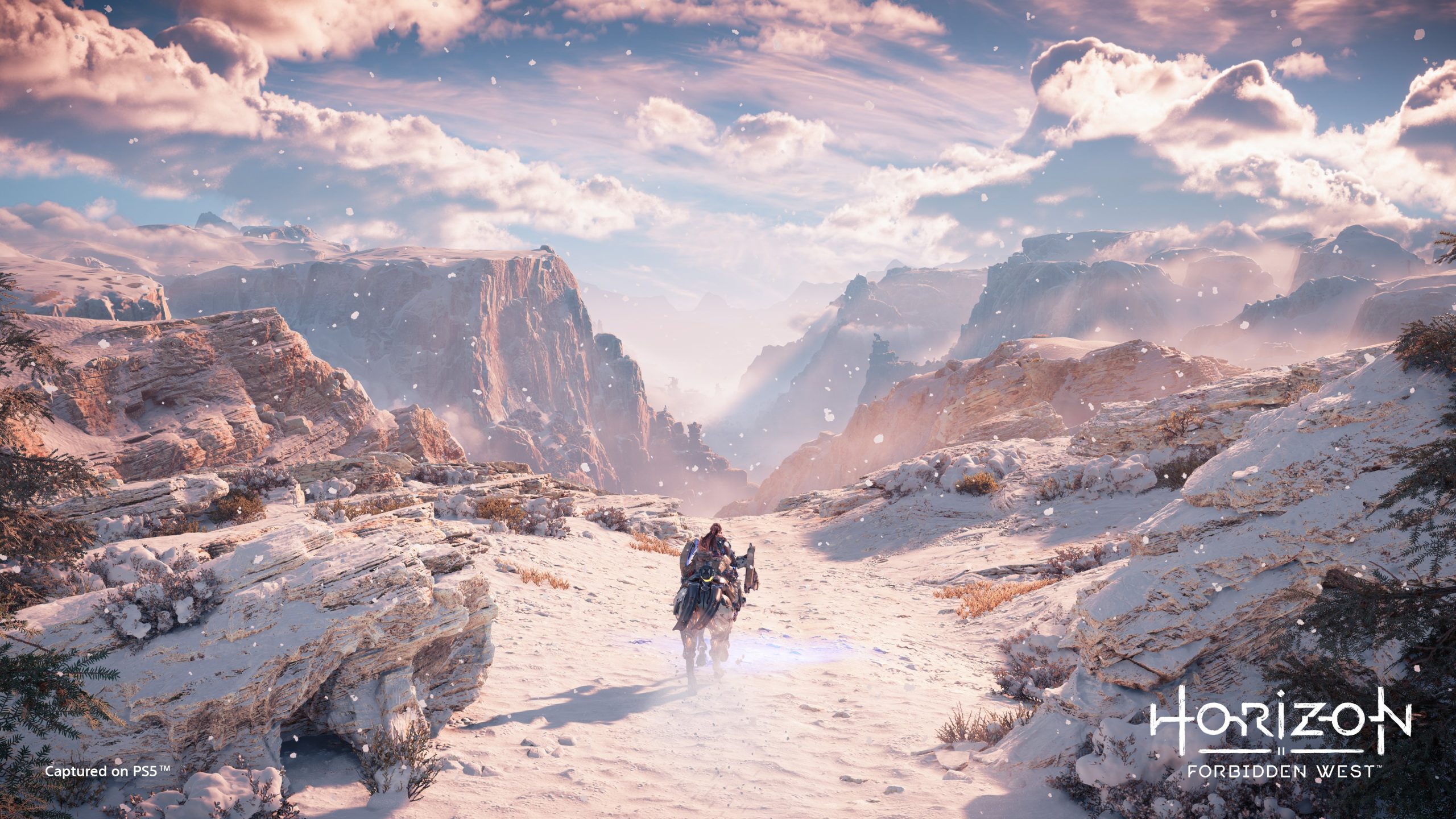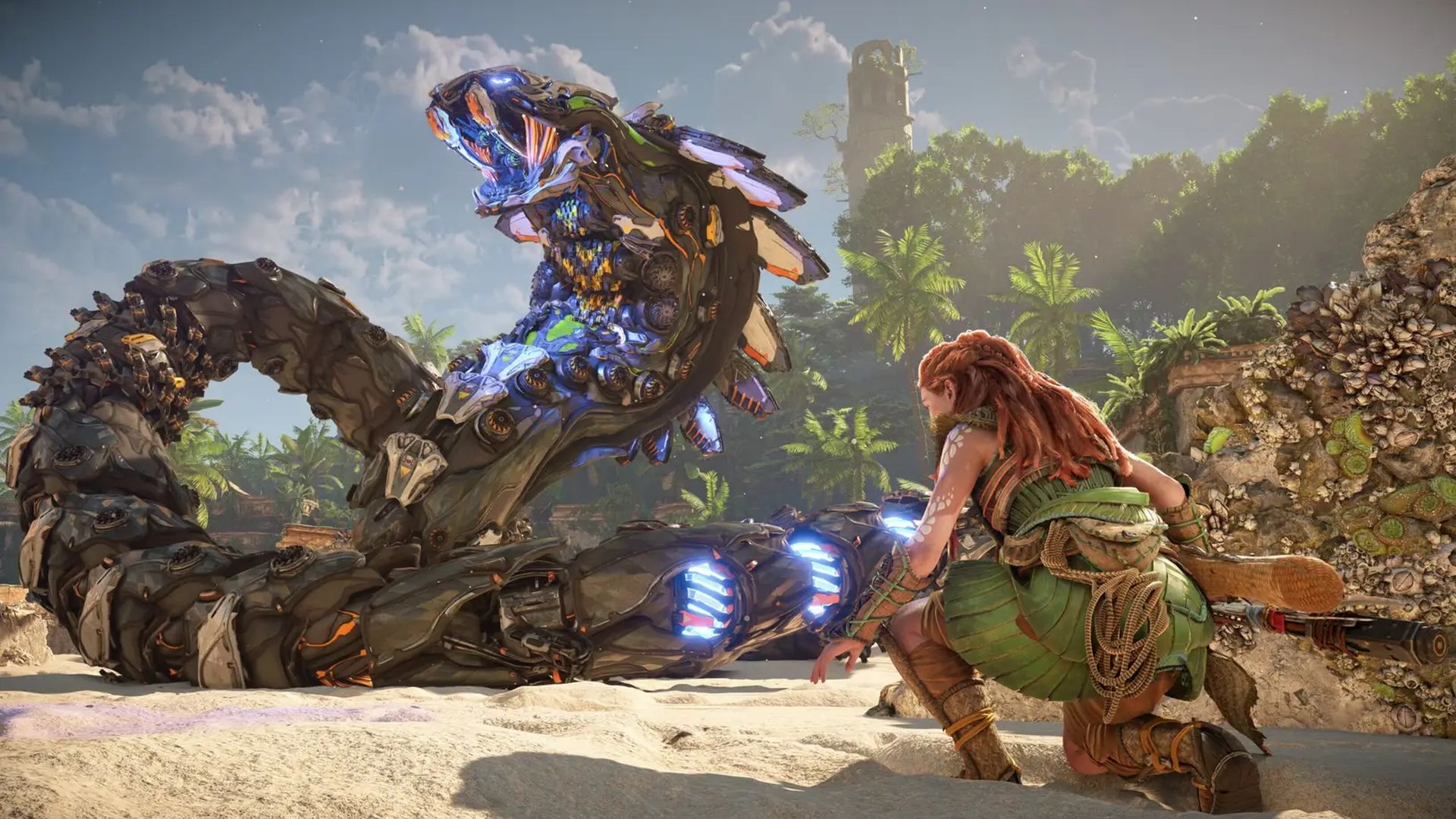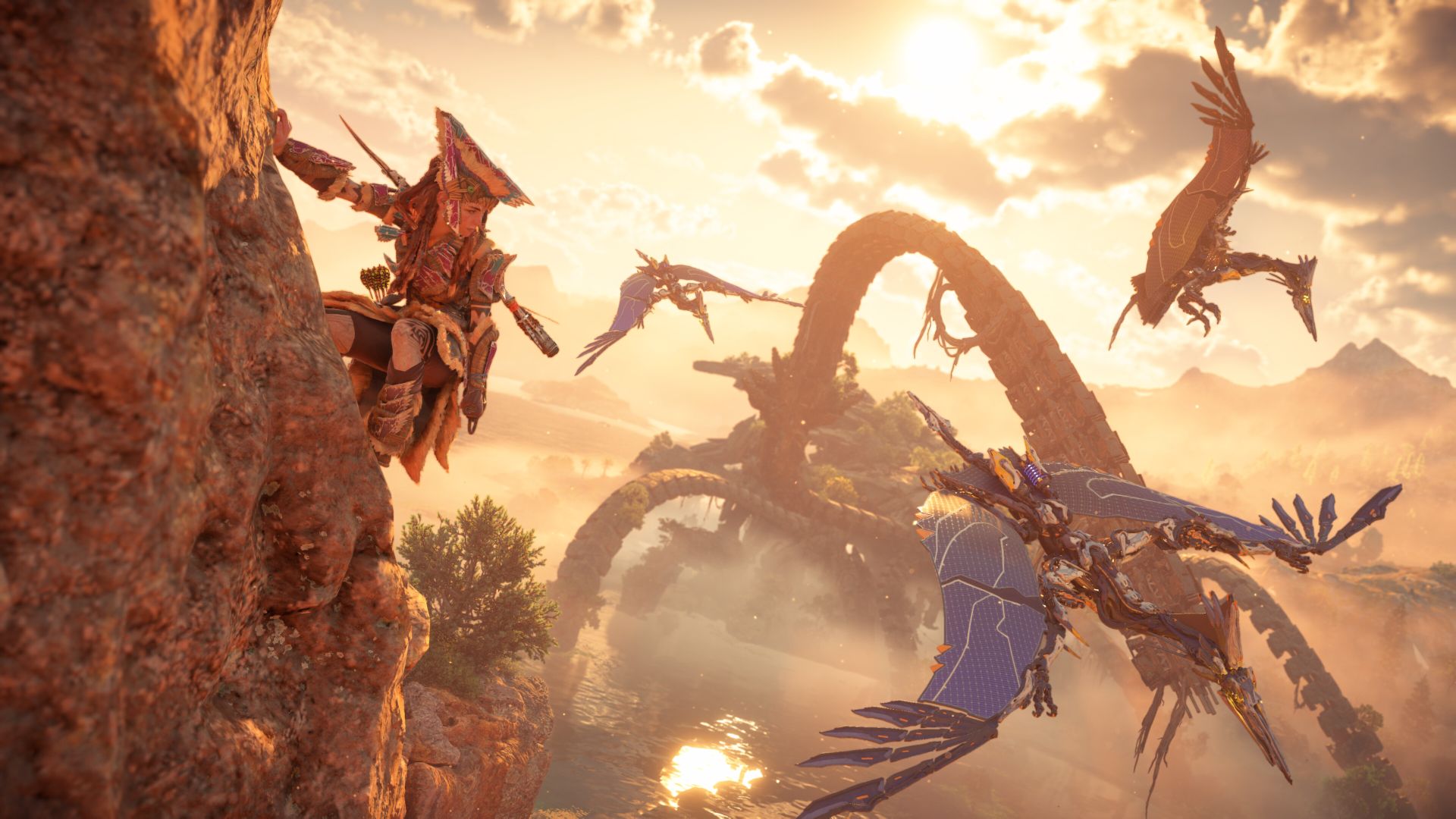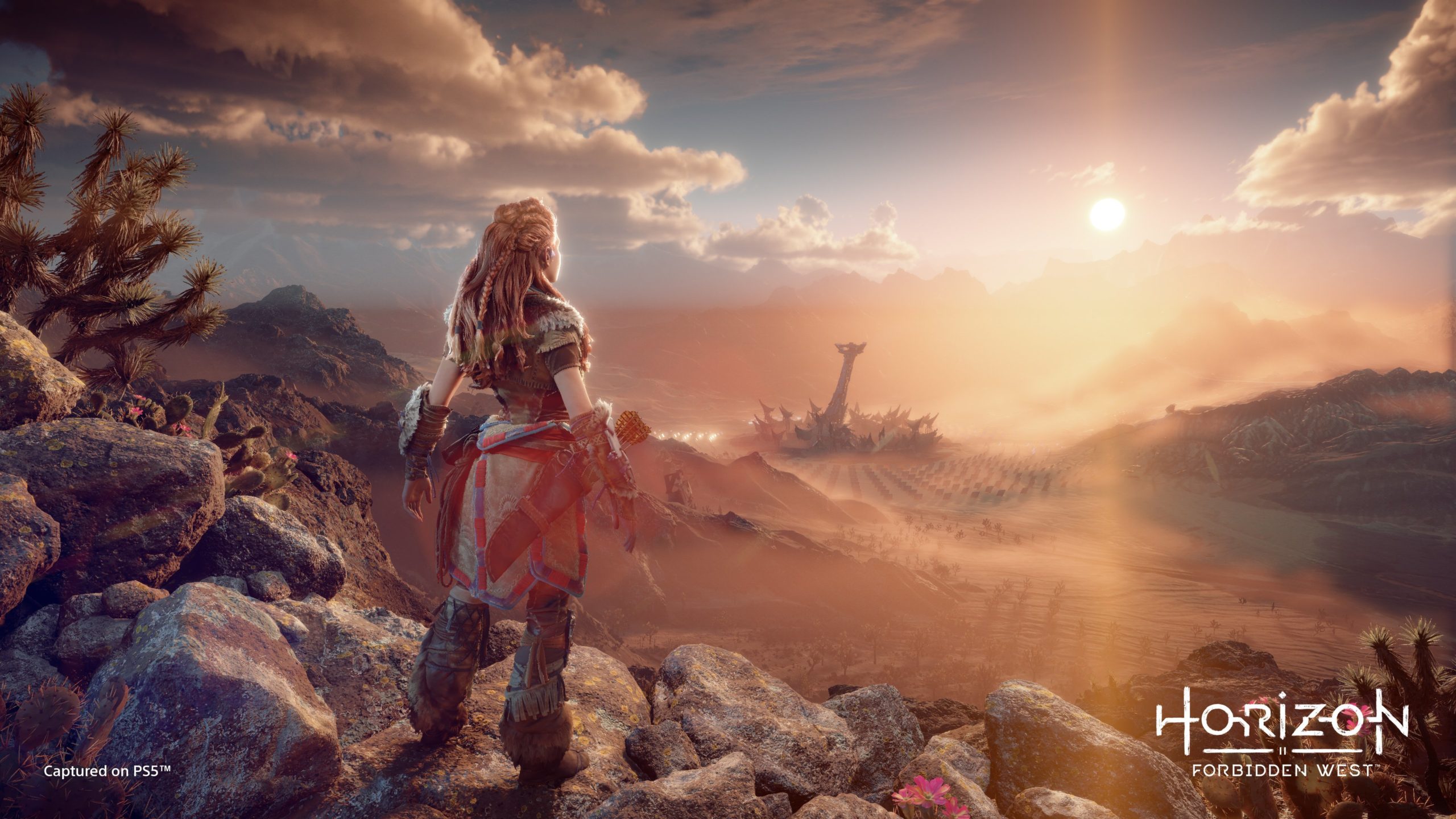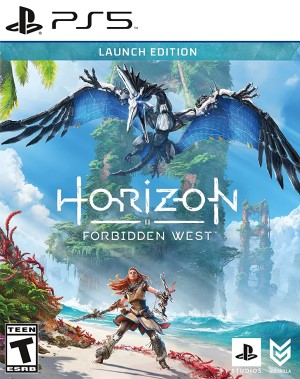
Guerrilla Games has enjoyed one of the most successful launches of the last generation with its 2017 release Horizon Zero Dawn. Despite being a brand new IP, Horizon was able to cement itself as one of the tent pole releases for the PS4 and its protagonist Aloy one of PlayStation’s premiere mascots. With 20 million copies sold across PS4 and PC, the developer is back at it once again with the highly-anticipated sequel Horizon Forbidden West, which looks to be building upon the excellent foundations established in the original to deliver a compelling experience that might very well be one of the best games of 2022.
This theme of improving over great beginnings continues in the technical department as well, with Horizon Forbidden West seemingly taking full advantage of both Sony’s current-gen machine the PS5 as well as its previous-gen machine the PS4 Pro. To make the game run as smoothly as possible on the two machines which have vastly different compute horsepower, the studio’s in-house Decima Engine has also seemingly received a ton of internal updates to its rendering pipeline to make the game both scale well across both platforms – all while delivering a markedly better experience on the lowest target platform.
To that effect, we present a complete technical analysis of Horizon Forbidden West and all of the improvements that it has over the original. Let’s begin!
The Rendering Pipeline
Guerrilla Games excellently adapted its Decima engine for Horizon Zero Dawn to seamlessly render a large open world that boasts a grand sense of scale alongside proper attention to microscopic detail. In addition to high polycount in character models, physically-based materials, and dense foliage, the Decima Engine boasts a robust post-processing pipeline with generous use of computationally taxing effects such as volumetric fog, high-range anisotropic filtering, screen-space reflections, and so much more. All of this impressive visual presentation was then capped off with MSAA.
Of course, that’s not to say that Horizon Zero Dawn didn’t make any sacrifices in achieving this level of detail for its post-apocalyptic world. Shadow maps can have a noticeably blurred appearance for objects that aren’t in the immediate vicinity of the player. There’s also no global illumination system in place, and reflections mostly utilize cube-mapping instead of the more accurate and computationally taxing screen space reflections that we saw many games using towards the tail end of the last generation.
Horizon Forbidden West shows some immediate changes to this visual presentation, although as previously mentioned – they are mostly iterative but noticeable upgrades over the original. For starters, the game does seem to have indirect lighting, presumably through the use of screen space reflections. Reflections are also of a markedly higher quality than before, most likely due to higher quality cube maps. Additionally, the game’s skybox rendering has also received a much-appreciated upgrade, courtesy of the Decima’s Nubis system which allows for rendering animated volumetric clouds.
Other than these, there aren’t new notable technologies that Forbidden West seems to be utilizing in its rendering pipeline – although the ones that are there certainly make this post-apocalyptic world an absolute looker on both machines. Note that this is not a criticism, but this is just the way the developers would have chosen to work with Forbidden West given that the game is a cross generational release.
An In-Depth Look at Character Models
Horizon Zero Dawn featured impressive high-fidelity character models across the board, although the main cast had a lot more micro-detail than other NPCs. The game also employed a primitive crowd system for its settlements, which allows for multiple NPCs to co-exist within the same space all while having their own animation cycles and primitive AI routines.
Coming to protagonist Aloy’s character model in Zero Dawn, it features some rather impressive hair physics of her own with each hair lock reacting independently to the character’s movements. Animations also seamlessly blend into each other to give a smooth experience controlling the character at all times. Another impressive detail is how the character’s limbs react to terrain slopes, resulting in the player speed increasing or decreasing when going downhill or uphill respectively.
Horizon Forbidden West iterates on this excellent presentation with a few new upgrades to the existing tech. The characters have similarly high polycounts across the board, although the facial meshes are a lot more detailed than before which complement the much-needed additions of facial animations very well. The characters also look much better thanks to cinematic lights which apply additional shading to these models to give them depth, although it needs to be noted that while the PS5 version has them enabled at all times the PS4 version only uses it in cutscenes.
The clothes that characters don are also composed of physically-based materials and have many more high-quality textures and meshes than before, which combined with highly-detailed models themselves create a pristine look all around. Cloth physics are also seemingly present, as the fur on the clothing as well as the edges of clothing reacts to the environment and wind accordingly.
Horizon’s signature hair physics makes a return, although it still suffers from the same issue of Aloy’s hair clipping through her bow at times. I acknowledge this might be a nitpick, but it’s still something that I found to be slightly off putting when the game otherwise looks so graphically stunning.
Another noticeable improvement comes in the form of enhanced facial animations for both Aloy and NPCs. The original game was criticized for its underwhelming facial animation and it’s great to see this being improved noticeably in the sequel. The game’s new settlements boast impressive crowd density and players will be able to notice a lot of new NPC animations during their travels.
The World Tech
The post-apocalyptic world of Zero Dawn is just a sight to behold. From the frigid Frozen Wilds to the grassy plains to the treacherous Oseram deserts, the game’s world is both diverse in terrain and huge in scale. The world streaming technology is really efficient, and the engine renders huge chunks of the map without any hitches. The terrain is also filled with large structures from the Old Ones as well as dense foliage, culminating in one great visual presentation.
The Forbidden West is home to many such diverse areas, all sporting even more visual fidelity in the terrain as well as the surrounding environments. The foliage is composed of higher-fidelity meshes and some trees are destructible allowing bigger machines to trample them down with relative ease, as seen with the Tremortusk blowing the palm trees to smithereens with its super strength.
Rendering huge amounts of complex terrain geometry has been one of Decima’s strongest suits (which might be part of the reason why Kojima Productions utilized it for Death Stranding). Aloy will be able to climb up a lot more surfaces than before in Horizon Forbidden West, which definitely adds some more complexity to the terrain geometry. Another notable point of improvement is the level of detail in shadow maps, which results in Forbidden West looking a lot sharper in faraway areas. The actual process of level of detail swapping also looks to be much smoother than in Zero Dawn, which contributes a lot to the game’s crisp and consistent visual presentation.
Horizon Forbidden West also features underwater exploration, and this new biome features a whole new set of flora and fauna. The water meshes look to be of extremely high quality, and ripples, waves, and bubbles in the water have impressive physics of their own – notably on the game’s PS5 version. Overall, the water seems to be a lot more detailed in Horizon Forbidden West than in Zero Dawn. Players can notice how the water trickles down the Tremortusk’s feet when it rises from the water, and also notice how individual water droplets are visible when Erend gets up after falling into a puddle of water.
Now, let’s get to the lighting. Much like Zero Dawn before it, volumetric light remains a strong element of the visual presentation for Horizon Forbidden West. The game extensively utilizes volumetric light shafts with light beams passing through the gaps in the treetops. In a similar vein, there’s also the use of fog to give a sense of scale to the game’s world, which also serves to mask low-level detail artifacts in the distance. As mentioned previously, the volumetric lights can also pass through gaps in the animated cloud meshes – thanks to Decima’s Nubis system.
Thick volumetric smoke can also be seen in explosions, such as when Aloy deploys a smoke bomb to hold off the machines from closing in. On the post-processing side of things, anisotropic filtering seems to be pretty much the same as before (most likely 8x or 16x) which does a great job of smoothing out far-away textures. Depth-of-field was used to focus on characters in cutscenes in Horizon Zero Dawn, and Horizon Forbidden West is no different in this regard. And much like Zero Dawn before, Forbidden West similarly uses both camera motion blur and per-object motion blur in its presentation.
The Machines
The machines have always been the star of the show for Horizon, and Forbidden West is unsurprisingly no different in this regard. These robotic creatures boasted impressive visual fidelity in Horizon Zero Dawn, with the machines boasting high polycounts coupled with complex geometry and physically-based materials. The machines that roam the Forbidden West are more dangerous, but share the same visual make-up as Zero Dawn.
A lot of what makes these machines look better than before can be attributed to the improved reflections and shadow tech of the world, which combines with self-occlusion to give the surfaces of the machines a better sense of depth and belonging to the world. That said, the evolved art direction also seems to be doing a lot of the heavy lifting here. For instance, notice how the cult tattoos on the Clawstriders and the Tremortusk contribute to an overall grittier look than before.
Another key improvement that fans might notice with regards to the Machines are the new animations, as they can now climb up surfaces and swim in the water to complement Aloy’s expanded moveset. Finally, Horizon: Zero Dawn’s systemic destruction of these machines makes a return in Forbidden West. Aloy can essentially target weak points of the machines using her Focus, and these parts will fall off the machines once enough damage is dealt. This forms an important part of the game’s combat system and an impressive showcase of the Decima’s physics systems.
PS5 Multiple Graphics Modes And How It Stacks Up Against the PS4 Pro Version
According to developer Guerrilla Games, Horizon Forbidden West is built with the PS4 as the target platform. As such, fans can expect the visual presentation to be mostly intact on the 8-year old machine. That said, PS5 is undoubtedly the best place to experience Horizon Forbidden West in all of its visual glory – thanks to the flexibility offered by multiple graphics modes along with the improvements that one can expect from the substantially more powerful machine.
Horizon Forbidden West on the PS5 offers two graphical modes – a resolution mode and a performance mode. The Quality mode targets a full 4K resolution and comes with all of the graphical bells and whistles included, with a target frame-cap of 30 fps. This allows the engine to produce a clean and crisp image, huge draw distances, 8x or 16x anisotropic filtering, high-fidelity reflections, and smooth LoD swapping and much more in this mode.
It’s all capped with what looks to be a multi-sampling anti-aliasing solution, most likely 4x.The performance mode will knock a few of these settings for a 60 fps performance and the resolution is most likely be dynamic in this mode or utilizing the same checkerboard rendering that Guerrilla Games used in the PS4 Pro version of Horizon Zero Dawn.
Coming to the PS4 Pro version, the game targets 30 frames per second. There are also some rather immediate visual downgrades to the experience. The PS5 version has an additional cinematic rig lighting for Aloy at all times, which is absent in the PS4 version. Aloy’s hair and her armor react more realistically on the PS5 than compared to the PS4 Pro version. Water physics on the PS4 are confirmed to be not as sophisticated as the PS5, which isn’t surprising considering how weak last-gen CPU hardware is when compared to current-gen.
On the PS4, draw distance seems to be shorter which is masked with the fog, and artifacts of level of detail swapping for shadows are particularly visible at the peripheral edges of the frame. The MSAA seems to have been replaced with a TAA solution, which when combined with what looks to be an already upscaled image culminates in mushy visuals. Depth of field and motion blur are of markedly lower quality, and so is the case with the resolution of explosion effects. The PS5 version suffers from minor pop in issues but it’s pretty bad on the PS4 Pro and it might be an immersion breaker for some players. Volumetric details are also toned down in the PS4 Pro version.
Load times are much faster on the PS5, thanks to its powerful SSD. On the PS4 Pro, as expected, the loading times are much longer. Load times to load the in-game work bench are also longer on the PS4 Pro although why this is the case is something beyond us.
Again, despite the many sacrifices with the PS4 Pro version – Horizon Forbidden West retains its look which is an impressive feat of its own. But if you can find a PS5, Horizon Forbidden West is best played on Sony’s latest machine.
Conclusion
Horizon Forbidden West marks a new era for developer Guerrilla Games, and its Decima Engine has certainly evolved for this generation. Horizon Forbidden West clearly builds upon the strengths of Zero Dawn. From the complex terrain to the striking art design of the machines to well-made character models, the game’s post-apocalyptic world looks stunning. But perhaps, what’s most impressive is how scalable the technology is – as even the almost six year old PS4 Pro runs the game provided you can accept its shortcomings.
In conclusion, Horizon Forbidden West is a visual showcase for the power of PS5, and Guerrilla Games seems to have done a fantastic job with the game overall.









